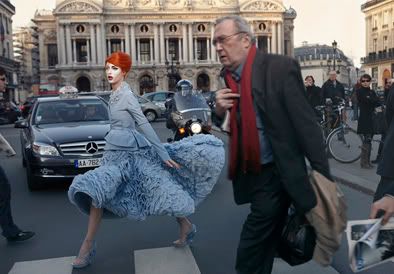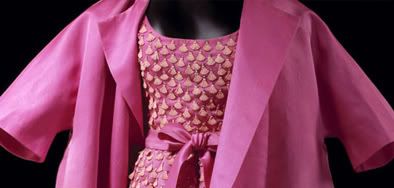
The exhibition recounts, on an inspiring way, the story of couture, beginning in the second half of the nineteenth century. This historical story is told by exclusive creations made by top designers, but also design drawings, accessories, fabric samples/swatches, embroideries, moving images and photographic material.
The Gemeentemuseum Den Haag owns one of the largest fashion collections in Europe, in which many of the well known couture houses are represented. It includes early pieces of couturiers like Worth, Poiret and Vionnet who where the forerunners of couturiers but also createurs (designers fashion) like we know them nowadays. The collection also contains famous or iconic items like for example the original pink Givenchy dress that Audrey Hepburn wore in Breakfast at Tiffany’s

Next to the historical showcase of haute couture the exhibition highlights contemporary couture. Renowned fashion houses, such as Dior, Chanel, Christian Lacroix and Jean Paul Gaultier, have loaned exclusive couture creations from their most recent collections.In a parallel to the international history of couture the exhibition features also the history of Dutch couture and shows the work of notable dutch couturiers like Frans Molenaar and Fong Leng but also work from the new generation of Dutch couturiers like Jan Taminiau.
The curator and art director of the exhibition is Maarten Spruyt, who was also responsible for previous fashion exhibitions for the Gemeentemuseum, including Fashion NL: the next generation (2006), Hague Court Fashions (2007) and The Ideal Man (2008). This exhibition is part of Holland Art Cities and it will run untill 6th June 2010.
During the Industrial revolution, Yorkshire and Scotland both became big centres for woollen goods manufacture. In the 1950s Britain was the largest exporter of wool textiles in the world and after the Second World War woollen good were used to help the UK export economy recover even though UK residents were deprived of the very same goods, until clothes rationing was removed.
Even though the UK textiles manufacturing sector has contracted over the years, in 2004 what remains is an important part of the UK industry. Cloth produced by mills in Yorkshire and Scotland is sought after globally by discriminating designers and purchasers. However, the market is smaller as third world companies compete. Because traditional methods are used to produce many of the tweeds and tartans from the UK the technique produces a fabric that is unrivalled in quality in terms of texture and handle.
The last couple of decades has also seen the introduction of lighter weight woollen materials more suited to the modern world. When I think of quality British tweeds I think of Harris Tweed, Linton Tweeds and Bernat Klein Tweeds. The 3 names offer different textural qualities in tweeds that captures the word exactly.
Harris Tweed is perfect for the new equestrian fashions for autumn/ winter 2004/5. No other material looks as good made up as a traditional tailored riding or hacking jacket.
There are many producers of cloth in the, UK but the most world famous woollen cloth of all is probably the Harris Tweed. Harris tweed is made in Britain and British tweed is the finest in the world. To be precise Harris tweed can only be woven in the outer Islands off Western Scotland in the Hebrides.
In the early Victorian era in the 1840s the wife of the Laird of Harris, Lady Dunmore encouraged the local weaving economy to promote the sales and production of Harris tweed.
Usually the wool comes from mainland Scotland and is transported to the islands where it is cleaned and dyed. After it is carded and blended it is warped onto wooden frames which are sent out to individual crofters with enough yarn to fill in for the weft (woof). They weave the material according to precise Harris pattern requirements on their time-honoured Hattersley looms.
Every weaver involved has to sign the British Harris Tweed Authority agreement that they wove the yarn by hand. The isle of Lewis deals with finishing the cloth which includes cleaning it of the oils that kept it from splitting during weaving and then milling and cropping it, until it has the desired handle for tailoring use. The finished tweed is stamped with a certification mark to ensure it is recognised as true Harris Tweed.

No comments:
Post a Comment